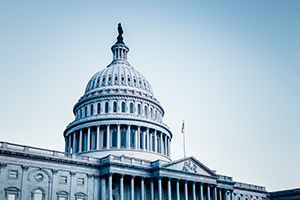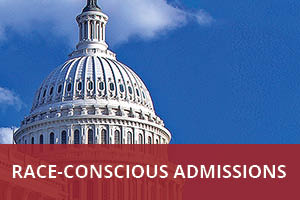by CUPA-HR | June 29, 2023
This morning, the Supreme Court issued rulings for the cases Students for Fair Admissions v. Harvard and Students for Fair Admissions v. University of North Carolina (UNC), both of which concerned the use of race-based affirmative action in admissions decisions at colleges and universities. The court ruled in favor of Students for Fair Admissions, ultimately striking down the practice of race-conscious admissions decisions on campus.
The Decision
In a 6-3 decision written by Chief Justice John Roberts, the court held that Harvard’s and UNC’s admissions programs violate the equal protection clause of the Fourteenth Amendment. To summarize his arguments, Roberts noted that using a racial classification is only constitutionally permissible if doing furthers a “compelling governmental interest” and is “‘narrowly tailored’— meaning ‘necessary’— to achieve that interest.” He added that while “remediating specific, identified instances of past discrimination” can constitute a compelling interest that justifies race-based state action, “ameliorating societal discrimination does not.” Roberts continued by stating that “[u]niversity programs must comply with strict scrutiny … may never use race as a stereotype or negative, and — at some point — they must end.” He finished by stating the “respondents’ admissions systems — however well intentioned and implemented in good faith — fail each of these criteria [and] therefore [are invalid] under the Equal Protection Clause of the Fourteenth Amendment.”
As an initial matter, Roberts noted that for universities to operate a “race-based admissions programs in a manner that” satisfies constitutional muster, it must be “‘sufficiently measurable to permit judicial [review].’” He found both universities failed to do so, stating:
“Harvard identifies the following educational benefits that it is pursuing: (1) ‘training future leaders in the public and private sectors’; (2) preparing graduates to ‘adapt to an increasingly pluralistic society’; (3) ‘better educating its students through diversity’; and (4) ‘producing new knowledge stemming from diverse outlooks.’ (…) UNC points to similar benefits, namely, ‘(1) promoting the robust exchange of ideas; (2) broadening and refining understanding; (3) fostering innovation and problem-solving; (4) preparing engaged and productive citizens and leaders; [and] (5) enhancing appreciation, respect, and empathy, cross-racial understanding, and breaking down stereotypes.’ (…) Although these are commendable goals … it is unclear how courts are supposed to measure any of [them].”
Secondarily, Roberts found the “respondents’ admissions programs fail to articulate a meaningful connection between the means they employ and the goals they pursue,” as well as “how assigning students to (…) racial categories and making admissions decisions based on them furthers the educational benefits that the universities claim to pursue.” Roberts states that “[r]acial classifications are simply too pernicious to permit any but the most exact connection between justification and classification.” On this point, Roberts concluded that the “categories [used by the universities] are themselves imprecise in many ways” and that institutions “would apparently prefer a class with 15% of students from Mexico over a class with 10% of students from several Latin American countries, simply because the former contains more Hispanic students than the latter.”
Additionally, Roberts states that “race may never be used as a ‘negative’ and that it may not operate as a stereotype,” and he argues the universities’ admissions policies failed because they did both. With respect to the first item, Roberts said “the District Court observed that Harvard’s ‘policy of considering applicants’ race (…) overall results in fewer Asian American and white students being admitted.’” With respect to the stereotypes, he found the policies at issue allocated preference to those “who may have little in common with one another but the color of their skin [and that t]he entire point of the Equal Protection Clause is that treating someone differently because of their skin color is not like treating them differently because they are from a city or from a suburb, or because they play the violin poorly or well.”
Finally, Roberts found that “admissions programs also lack a ‘logical end point,’ which the majority found was needed under the court’s jurisprudence.
The chief justice closed his opinion by stating that colleges and universities are not prohibited from considering an applicant’s “discussion of how race affected his or her life, be it through discrimination, inspiration, or otherwise,” but institutions are banned from establishing admissions programs and practices that explicitly consider race. The opinion elaborates, “A benefit to a student who overcame racial discrimination, for example, must be tied to that student’s courage and determination. Or a benefit to a student whose heritage or culture motivated him or her to assume a leadership role or attain a particular goal must be tied to that student’s unique ability to contribute to the university. In other words, the student must be treated based on his or her experiences as an individual — not on the basis of race.”
Justices Sonia Sotomayor, Elena Kagan and Ketanji Brown Jackson issued a dissenting opinion in both cases (To note: Jackson did not take part in considering the decision in the Harvard case due to her previous connection with Harvard College). Sotomayor wrote in the dissenting opinion that the court’s decision “rolls back decades of precedent and momentous progress” and that it “holds that race can no longer be used in a limited way in college admissions to achieve such critical benefits,” which “cements a superficial rule of colorblindness as a constitutional principle in an endemically segregated society where race has always mattered and continues to matter.”
In August 2022, CUPA-HR joined the American Council on Education and others in filing an amicus brief in support of Harvard and UNC. The brief argued that the Supreme Court should rule in favor of preserving race-conscious affirmative action, as has been made precedent for decades. The brief highlights the value of considering race and ethnicity during the admissions process and the broader impact such initiatives have for institutions’ efforts to increase diversity on campus.
The Decision
Prior to the rule’s issuance, stakeholders also raised concerns with the impact the decision could have on employers’ hiring and employment decisions as well as any diversity, equity and inclusion (DEI) programs or initiatives. Today’s decision to strike down race-based affirmative action in admissions practices could leave employers open to future legal challenges against their hiring decisions and other diversity programs.
CUPA-HR strongly supports the need to create and sustain diverse, inclusive college and university communities. We’re disappointed that the Supreme Court’s action has limited our efforts. CUPA-HR’s government relations team is further analyzing the decision and will keep members apprised of any additional updates as it relates to these cases.
Share This Article:



